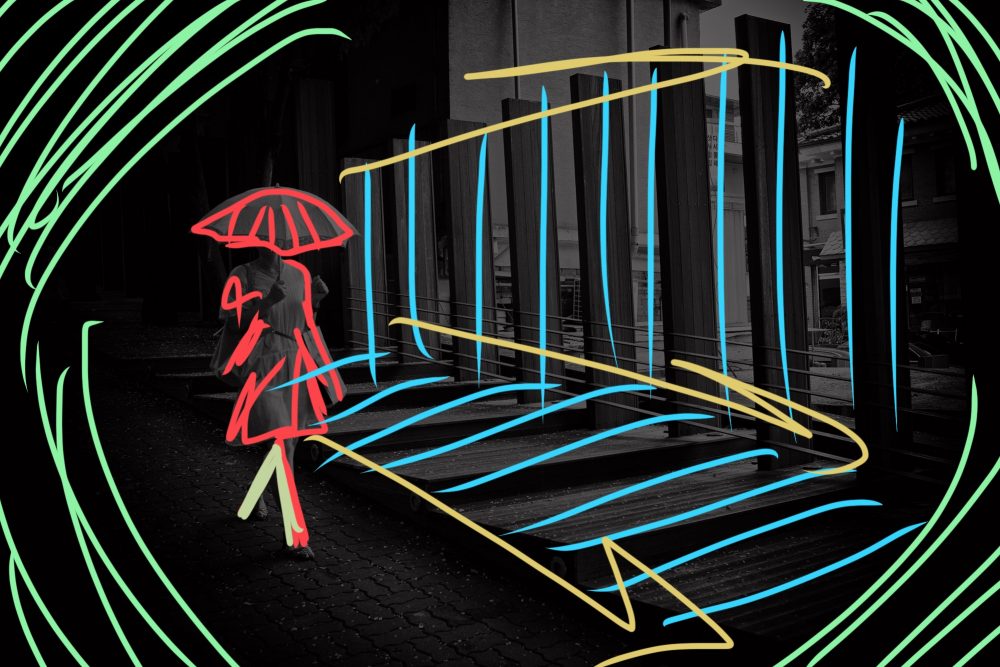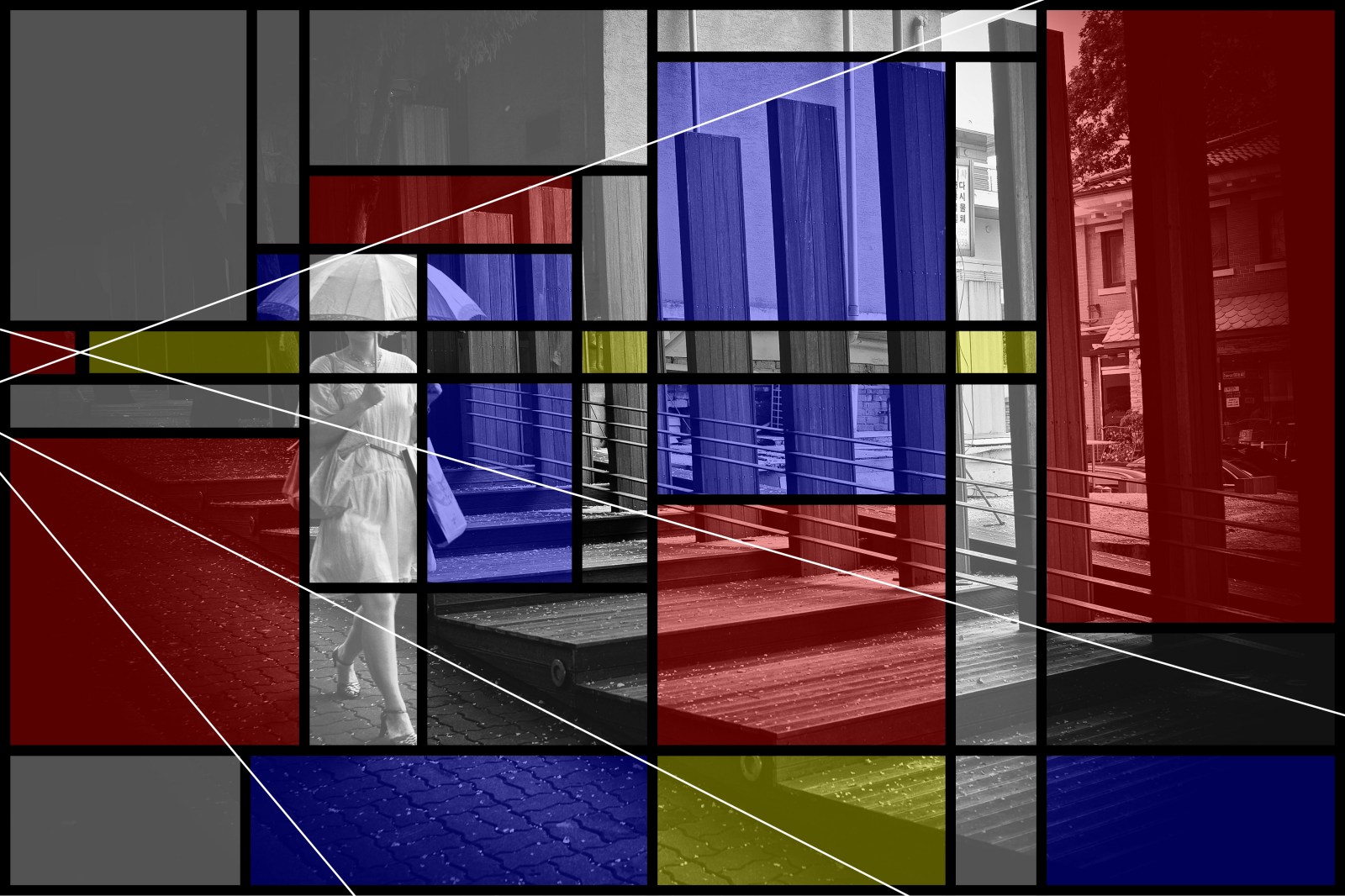Composition in photography is this:
To construct, to build, prepare, and put together/arrange an image.
Opposite of destroy?

The word “destroy” comes from de-struo (to un-create).
Thus, in simple words: composition in photography is to construct/build an image. You do this by 1) Preparing for the photograph (planning to take a photo BEFORE a decisive moment), and 2) Placing and arrange visual elements in a frame.
1. How to arrange visual elements in a frame

Consider photography like visual Tetris. You look for building blocks, and decide how to re-arrange the blocks:

For example, look at the picture above. Some questions I might ask myself:
- How much of the red should I show, versus the blue?
- Do I prefer to shoot this picture as a vertical (portrait orientation) or a horizontal (landscape orientation)? Or– do I prefer to tilt the photo?
- How close do I get to the thing I want to photograph, or how far away? For example in the above picture, I took lots of photos on 28mm lens (Ricoh GR II), at different distances. I took around 10 photos, and decided to keep the above photo, because I felt it had the most dynamic balance.
2. What is my subject-matter (what do I want to photograph)?

If you want to make a good photo, you need a strong single subject-matter to photograph. This can be your hand, a body part, a face, or something else.
As a practical tip:
When you’re photographing a scene, try to highlight the 1 primary subject.
3. Keep it simple

When you’re composing a scene, keep it simple. My suggestion is to get close to your subject-matter, and fill the frame with it. You can do this by looking at the corners of the frame while you’re composing.

An activity:
Try to make an ‘extremely simple’ photograph– by only showing the extreme minimum in the photo.

4. Center the eye

Put your subject’s eye in the center of the frame. Raphael did this well with his portraits.
5. Outline

Edge detection. You need to have separation between visual elements in your frame and the background.

6. Analyze your photos after-the-fact
When you are shooting photos, it is difficult to always ascertain whether a composition will be good or not. Thus, analyze your photos after-the-fact.

Conclusion: Compose like a child

Study the paintings, drawings, and compositions of children. They do it quite naturally.
Remember– to compose is to create. Compose more photos; create more photos.
ERIC
Composition 101

Master composition for yourself:
Photography Composition Concepts

- Edge Detection Photography Composition
- Vector (Arrow) Photography Composition
- Clear and Obscure (Chiaroscuro) Photography Composition
Photography Composition Tips

- How to Photograph Motion
- Photography Composition: Which Direction is Your Subject Looking?
- Blocking Technique in Photography
- How to Shoot a Triangle Photography Composition
- How to shoot a golden triangle composition in street photography
- 8 Simple Curve Composition Tips
- 5 Simple Henri Cartier-Bresson Composition Tips
- Foot Zoom
- Photography Composition: Light and Dark
- Street Photography Composition Lesson #16: Scale
- Shape, Arrangement, Position (S.A.P.) and Contour, Inter-Contact, Position (C.I.A.) in Photography
- 10 Tips How to Fill the Frame in Photography
- Look Up! 16 Photography Composition Perspective Tips
- 5 Simple Street Photography Composition Tips
- Depth Perception
- Golden Angle Composition in Street Photography
- Photographer as an “Arranging Artist”
- Dynamic Off-Center Street Photography Compositions
- 5 Essential Composition Tips in Photography
Color Theory

- Red and Green Composition Color Theory For Photographers
- The Ultimate Beginner’s Guide to Color Photography
- Opponent Process Color Theory For Photographers
- Color Theory For Photographers
- Color Manual
- How to Shoot Color Street Photography
Learn From the Masters of Composition

- 10 Lessons Matisse Can Teach You About Art and Life
- Henri Cartier-Bresson Composition
- 10 Timeless Lessons Edward Weston Can Teach You About Photography
- 10 Inspirational Sergio Larrain Compositions
- 5 Henri Cartier-Bresson Photography Composition Lessons
Dynamic Photography Composition 101

- Introduction to Dynamic Photography Composition
- How to Visually Analyze Your Photography Compositions
- Dynamic Tension: Opponent Based Theory For Photography
- Opponent Process Color Theory For Photographers
- Dynamic Photography Composition 101: Figure to Ground
Painting Compositions

Dynamic Photography Composition Tips

- 7 Simple Photography Composition Tips
- How to Make Aggressive Photography Compositions
- 10 Dynamic Photography Composition Tips
- How to Make More Dynamic Picture Compositions
- Unorthodox Photography Composition Techniques
- Deconstructed: Saigon Eric Kim Photos
Composition Theory

Take your composition to the next level:
- Gestalt Theory
- Juxtaposition
- Center Eye
- Low-Angle
- Dutch Angle
- Deep Depth
- Spacing
- Silhouette
- Leading Lines
- Figure to Ground
- Fibonacci Spiral
- Cropping
- Emotion
- Composition by Eric Kim
Street Photography Composition 101

For distilled lessons on composition, read the free ebook: “The Street Photography Composition Manual.”
Further articles to improve your compositions in photography:
- Composition Lesson #1: Triangles
- Composition Lesson #2: Figure-to-ground
- Composition Lesson #3: Diagonals
- Composition Lesson #4: Leading Lines
- Composition Lesson #5: Depth
- Composition Lesson #6: Framing
- Composition Lesson #7: Perspective
- Composition Lesson #8: Curves
- Composition Lesson #9: Self-Portraits
- Composition Lesson #10: Urban Landscapes
- Composition Lesson #11: “Spot the not”
- Composition Lesson #12: Color Theory
- Composition Lesson #13: Multiple-Subjects
- Composition Lesson #14: Square Format
Composition Theory

Learn compositional theory:
- Why is Composition Important?
- Don’t Think About Composition When You’re Shooting Street Photography
- How to Use Negative Space
- Street Photography Composition 101
- The Theory of Composition in Street Photography: 7 Lessons from Henri Cartier-Bresson
Compositional lessons from the masters of art
Composition lectures
Composition pictures/grids


Golden Diagonal Composition



















